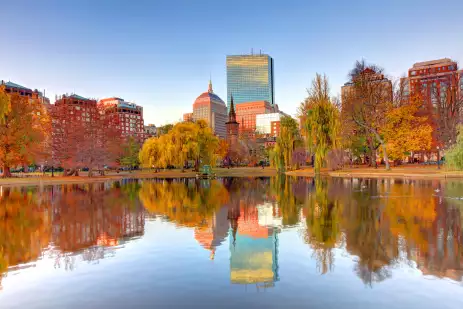Things To Know Before Visiting the USA

Known for being bigger and bolder, the United States offers a kaleidoscope of experiences, From the neon buzz of Times Square to the serene stillness of the Grand Canyon. But before you dive into your American adventure, there are a few essential things to know. This guide covers everything from visa rules and customs to tipping etiquette, weather, and safety—so you can travel smart and stress-free.
Do I Need a Visa for the USA from the UK?
British citizens planning a short trip to the U.S. for tourism, business, or transit, likely don’t need a traditional visa. Instead, you'll need to apply for an ESTA (Electronic System for Travel Authorization) under the Visa Waiver Program (VWP).
As long as you have no criminal record or prior immigration violations, it's relatively quick and easy to get an ESTA. If you are visiting as a tourist or for business purposes, apply online - be sure you have the official ESTA website to avoid scams - and you can stay for up to 90 days. (That's plenty of time to explore!) The ESTA is then valid for 2 years or until your passport expires.
Please note: if you've visited Cuba since January 2021 or Iran, Iraq, North Korea, or Syria since 2011, then you’ll need to apply for a B-2 Tourist Visa through the U.S. Embassy in London instead.
What to expect at US Customs
- While the US border control is known for being thorough, with our tips the process is much easier to navigate:
- Keep your ESTA confirmation, hotel bookings and return flight or onward travel details handy.
- Be prepared to answer questions about your trip, the purpose of your visit and the length of stay. Be honest and straightforward - border control isn't known for its sense of humour!
- Turn off your phone and any other electronic devices, or ensure they are properly secured with a password, before entering the US border control area to protect your privacy.
- Remember to declare items like food, alcohol and cash over $10,000.
Transport tips for travelling around the US

The USA is 9.867 million km² - that's approximately 40 times bigger than the UK - so once you've entered the country, the next question is how do you get around? Transport options largely depend on where you are going.
In the city, public transport could be an option - in big cities, such as New York, Washington D.C., Chicago, and Boston, have great public transport - like subways and busses. But in smaller cities and towns, reliable public transport is less common. Rideshare options like Uber and Lyft are widely available and often cheaper than taxis so if you want to explore, we recommend downloading one of the apps before you travel.
If you're heading out into rural areas - or visiting the national parks - consider renting a car. Remember in the US they drive on the right side of the road and most cars are automatic.
For long-distance travel, consider booking a domestic flight to save travel time. For example, travelling from New York to Los Angeles will take you around 6 hours by plane and 40-50 hours driving. Remember to book early for better prices. While travel by train might not be the most time-efficient travel option, there are many scenic routes which become an experience in themselves:
- The California Zephyr travels from Chicago to Omaha, Denver and Salt Lake City, ending in Emeryville, San Francisco. The entire journey takes 51 hours and 20 minutes, though you can choose to only do part of the journey. Highlights include scenic views while travelling through the heart of the Rocky Mountains and the Sierra Nevada, as well as its journey through the plains of the Midwest.
- The Coast Starlight starts in Seattle, travelling to Portland, Sacramento and Los Angeles. The entire journey takes 35 hours, and, along the way, you'll be treated to dramatic snow-covered peaks of the Cascade Range and Mount Shasta, lush forests, fertile valleys and long stretches of Pacific Ocean shoreline.
- On the Empire Builder, you'll be travelling in the footsteps of early pioneers. The journey starts in Chicago making its way to Minneapolis and Spokane, before ending in Portland or Seattle.
Tipping etiquette in the US
Tipping in the US is not optional in the US, it's part of the wage system. The federal minimum wage for tipped employees is only $2.13 per hour, compared to $7.25 for non-tipped workers (true of June 2025), it's hoped that combined with tips this reaches the full federal minimum wage.
As a general rule, tip 15-20% of the bill at restaurants, but be sure to check the bill before you tip, some restaurants automatically include gratuity. Consider a $1-$2 tip per drink while at a bar and 10-15% for taxis and rideshares. In hotels, $2-$5 per night for hotel housekeeping and $1-$2 per bag to bellhops, are considered fair.
What to pack when travelling to the US
The United States is massive, it spans six time zones and nearly every climate imaginable - from arid deserts to tropical beaches, alpine peaks and humid swaps. To properly pack, you need to understand where you are going and when.
Northeast USA

Encompassing popular cities like New York, Boston and Washington D.C., summer (June to August) in the northeast is hot and humid with occasional thunderstorms so packing light breathable clothing is a must. Make sure you add both sunscreen and an umbrella to your packing list so you're ready for anything!
Winter in New York is a bucket list travel experience for many. If you're heading to the northeast in winter, prepare for cold and often snowy conditions. Bring a thick coat, gloves, scarf and thermal layers as well as waterproof footwear for all the snowy sidewalks.
Spring and autumn - or fall as they call it there - can be unpredictable so pack layers, light jackets and a raincoat.
Southeast USA

As you'd expect from the eastern portion of the Deep South, places like Florida, Georgia and the Carolinas are very hot and humid in the summer and afternoon thunderstorms are very common. Pack lightweight, moisture-wicking clothes, sandals and a rain poncho - in case you get caught out!
Winter's are mild and pleasant so a light jacket or sweater is usually enough to keep you comfortable.
From June to November is hurricane season in Florida with its peak in September - we recommend you check the forecast before travelling. 'Direct hits' are rare but not unprecedented and even close calls can cause destruction and travel disruptions.
Southwest USA

Arizona, Nevada, and New Mexico conjure up images of barren deserts for good reason. Summer in the southwest is extremely hot, especially in desert areas like Las Vegas and Phoenix. You need to protect yourself from the sun so pack sun hats, sunglasses, SPF 50+ and breathable long-sleeve tops for maximum sun protection.
Winter is much more bearable with mild, pleasant weather - a fleece or light jacket is ideal.
Bear in mind that temperatures in the desert drop quickly at night so pack something warm, even in summer.
Mountains States

Mountain states like Colorado, Montana and Wyoming offer warm days and cool nights - ideal for hiking. Bring layers, a waterproof jacket and, of course, hiking boots if you plan to explore on foot.
Winter in these regions is ski season - the cold and snowy climate makes thermals, jumpers, ski gear and insulated outerwear a must!
Many destinations in these states are at high altitudes so remember to hydrate well and bring lip balm and moisturiser to avoid altitude sickness.
Midwest

Summers in cities like Chicago, Minneapolis and Detroit are hot and humid - thunderstorms are common - so pack light clothing, sunscreen and a rain jacket to cover all your bases.
Winter is bitterly cold with snow and ice so heavy-duty winter gear is essential - pack your parkas, thermal socks and snow boots. In spring and autumn, the weather is changeable so we recommend packing layers and checking the forecast before you travel.
Health and safety tips for travelling to the US
Healthcare in the US is not free, as it is in the UK - even small injuries can cost thousands of dollars. Emergency care can exceed $1,000 on average for just an ambulance ride and without cover, treatment may not be provided. This makes holiday insurance essential. Make sure you know how to contact your insurer in case of an emergency and keep the British embassy or consulate contact information saved somewhere for assistance with non-medical emergencies.
In the case of an emergency, dial 911 for the police, fire or medical services.
While the US is generally considered safe for tourists, it's important to take common-sense precautions:
- Stay in well-lit, populated areas, especially at night. Avoid wandering into unfamiliar neighbourhoods without researching them first.
- Use official transport options like licensed taxis, Uber, or Lyft. Avoid unmarked vehicles offering rides.
- Keep valuables out of sight—especially phones, wallets, and passports. Use a crossbody bag or money belt in crowded areas.
- Be cautious at ATMs, especially at night. Use machines inside banks or well-lit public places.
- Use the hotel safe for passports, extra cash, and electronics.
- Lock your doors and windows, even in high-rise hotels.
In national parks:
- Always carry water, snacks and a map,
- Let someone know your plans
- Stay on trail
- Never feed or approach animals




